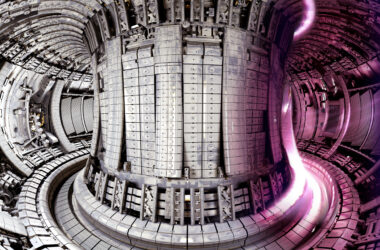Hinkley Point C (HPC), Britain’s first new nuclear power plant in over two decades, reached a significant construction milestone on December 15th, lifting the domed roof onto its first reactor building.
The nuclear plant has faced budget overruns and delays and is now on track to complete its first reactor in 2027. The successful heavy lift paves the way for further progress as the difficult work of finishing the nuclear island continues.
A precise choreography of workers and machines enabled the dome manoeuvre. Big Carl, currently the world’s strongest land-based crane, carried out it. With a maximum load of 5,000 metric tonnes, its precision heavy lift capacity was especially suited to positioning the 47-meter comprehensive structure. Careful weather monitoring allowed the lift to occur under low wind speeds for maximum control. The completed dome itself comprises 38 prefabricated steel panels welded together onsite.
Execution of the Lift
Starting at 07:20 GMT, Big Carl gracefully lifted the 245 metric tonne dome and rotated it into alignment with the reactor building’s roof support structure.
The lift took just 90 minutes, settling the dome by 08:50. Site director Simon Parsons said, “Building the first nuclear power station in a generation is a challenging job, and the success of this complex operation is due to the determination and commitment of our fantastic teams.” Government minister Andrew Bowie also hailed it as demonstrating continued progress for Britain’s nuclear power ambitions. “This is a major milestone in building Britain’s first nuclear reactor in a generation, and a key part of the UK government’s plans to revitalise nuclear.”
Significance of the Milestone
With the enclosure now complete, outfitting of the inner reactor containment cylinder can proceed on schedule.
This includes the nearby installation of Hinkley Point C’s first nuclear reactor, already stored and prepared onsite. Operational startup remains on target for June 2027, when the plant is set to supply 6 million UK households with low-carbon electricity. HPC will meet 7% of the country’s demand over a projected 60-year lifespan.
Concerns still overshadow the project’s ballooning budget, now £33 billion. This has led to questions over the guaranteed strike price that will subsidise HPC’s eventual power sales. Analysts estimate this could go over twice the market rate by 2028, losing money compared to cheaper wind power. These economic pressures have reportedly led investor CGN to halt further funding amidst political tensions. Nonetheless, nuclear still fills a role in Britain’s energy transition that renewables cannot yet provide alone.
With the dome now placed, Hinkley Point C’s first reactor can proceed through final assembly, instrumentation, and eventual activation.
The dome lift marks both a symbolic and practical milestone for what will be Europe’s largest generating station. While doubts remain whether HPC’s value will equal its expense, its completion promises to strengthen energy security for Britain’s low-carbon transition towards a net-zero future.
TLDR:
- On December 15th, workers lifted a 47m wide, 245-tonne dome onto the first reactor building at the Hinkley Point C nuclear plant.
- The successful “Big Carl” crane lift allows equipment installation in the reactor to stay on schedule
- Completion is targeted for mid-2027, enabling the reactor to power 6 million UK homes.
- But Hinkley Point C continues to face questions about its ballooning £33 billion budget and subsidised electricity pricing.
- The dome lift marks a symbolic and practical achievement despite economic concerns.








